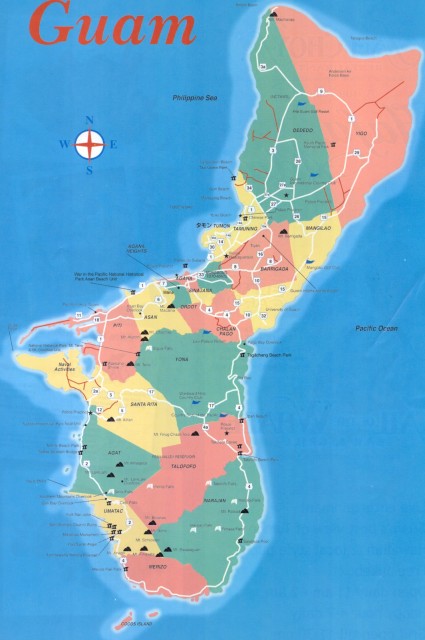Guam
A U.S. TERRITORY, the island of Guam is one of the largest islands in the north PACIFIC OCEAN, located about three-quarters of the distance from HAWAII to the PHILIPPINES.
Its harbor, one of the best in the world, underlies the importance the island has held for the last five centuries to foreign powers in the region, first SPAIN, and now the UNITED STATES. Guam is the southernmost island of the chain known as the Mariana Islands and has been a territory of the United States since 1898. Much of the local economy is dependent on the U.S. military presence and on heavy subsidies, so it is unlikely there will be any moves toward independence in the coming years.
The island is 48 mi (77 km) long and roughly 4 to 9 mi (6 to 15 km) wide. Its closest neighbors are the Northern Mariana Islands, a U.S. commonwealth, and the newly independent Federated States of MICRONESIA to the south. Guam lies at the crossroads of TRADE ROUTES, 1,488 mi (2,400 km) east of Manila (Philippines), 1,612 mi (2,600 km) south of TOKYO (JAPAN), and 3,658 mi (5,900 km) west of Honolulu, Hawaii.

Guam was formed by successive undersea volcanoes, which are older and more worn by erosion in the north, and younger in the south. The more hilly south has more streams and is thus more conducive to agriculture. The north is a coralline limestone plateau, with steep cliffs along the coasts. As part of the Pacific ring of fire, Guam also suffers from earthquakes. Coral reefs surround the island on all sides, causing some dangers for boats, which are increased by heavy swells and swift currents. Apra Harbor, located about 5 mi (8 km) southwest of the capital, is one of the best natural harbors in the Pacific, providing ample shelter during typhoons, which hit the island at least two times each year. The worst of these to strike in recorded history was in 1982, causing a great deal of damage.
The climate is maritime tropical, with little temperature variation, but increased rain during the southwest monsoons, July to October. Lush vegetation covers the island, with vines and palm trees, and tropical produce like bananas, breadfruit and coconut. Of particular value is the ironwood tree, termite resistant and extremely hard, now protected by law. There is limited natural wildlife, mostly birds, bats, insects, and sea turtles. The reefs have abundant tropical fish, squid and sharks. The nearby Challenger Deep in the Mariana Trench, at 35,838 ft (10,924 m) below sea level, is the deepest point on the planet.
The islands were populated by migrants, probably from the Philippines or Malay, who set up a number of chiefdoms based on matrilineal clans. Ferdinand Magellan landed here in 1521 on his way around the world and named the islands (the whole chain) the Ilhas das Velhas (“islands of sails” after the triangularshaped sails used by the natives, known as Chamorros).
They were also sometimes called, pejoratively, the Ilhas de Ladrones (“thieves”). Although renamed by Spanish authorities the Marianas, in honor of the Queen of Spain, Mariana of Austria, the natives continued to call their island Guahan, or Guam. The Spanish did not settle here, but used it as a stop-off point in their annual trade convoys between MEXICO and the Philippines. Jesuit missionaries arrived in the later 17th century, and permanent settlements began. Struggles with colonial administrators and the introduction of European diseases quickly reduced the native population from an estimated 50,000 to 100,000 in 1600 to a mere 5,000 by the end of the century, reaching record lows of about 1,500 in 1780. The United States took over the island from SPAIN in 1898 and established a large military presence; the island was at first essential as a coaling station for ships crossing the Pacific, then as a fueling stop for transpacific flights. After a brutal occupation by Japanese forces from 1941 to 1944, Apra Harbor served as a main airbase during the Vietnam War era.
Guam remains an unincorporated territory under the administration of the Department of the Interior. In a 1982 referendum, Guamanians requested commonwealth status, and a Guam Commonwealth Act, approved in two plebiscites, has been repeatedly submitted to Congress since 1988 but has been stalled, perhaps from U.S. military concerns on the island. Its culture is very American, and almost entirely urban. Most Chamorros seem happy with that, except there is a growing fear of being overwhelmed numerically by Filipino immigrants.